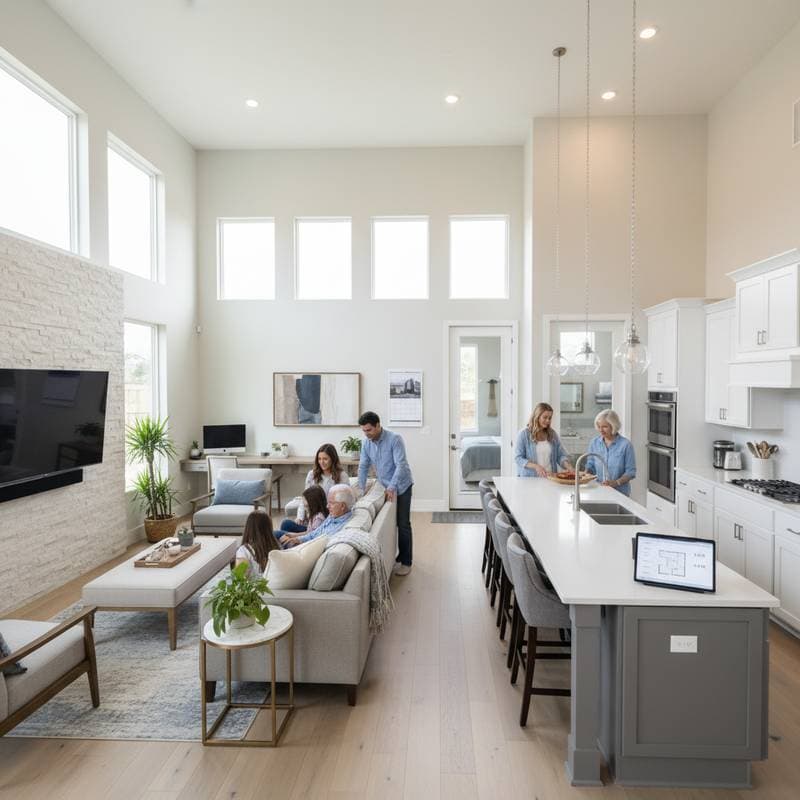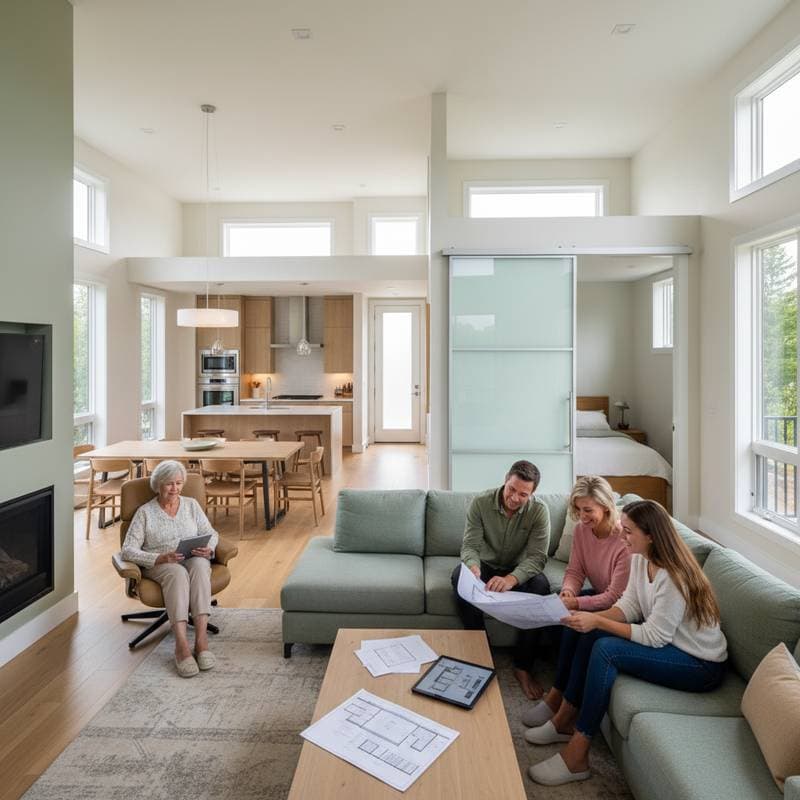Why Multigenerational Renovations Cost More Than You Think
Homeowners often view multigenerational renovations as straightforward updates, such as installing a kitchenette or reconfiguring a floor plan. These projects, however, frequently exceed initial estimates. The primary factors involve building codes, structural demands, and adaptations for diverse lifestyles that ensure safety and comfort across generations.
This guide details the elements that elevate costs, outlines project scopes, and provides budgeting strategies. Whether the goal involves creating an in-law suite, completing a basement for elderly relatives, or transforming a garage into an accessory dwelling unit (ADU), informed planning prevents financial overruns.
Pros, Cons, and Best-Fit Scenarios
Best Applications:
- Households accommodating aging parents with medical needs
- Families hosting adult children and grandchildren during transitions
- Property owners seeking supplemental rental income with maintained privacy
Advantages:
- Enhanced family support and emotional closeness over time
- Reduced overall utility expenses through shared infrastructure
- Increased property equity from adaptable living spaces
Disadvantages:
- Substantial initial investments in construction and compliance
- Navigating complex zoning regulations and permit processes
- Balancing personal space amid shared living arrangements
Multigenerational designs succeed most on properties with ample room for independent entrances, dedicated parking, and efficient airflow systems. In compact urban settings or modest homes, expenses rise due to the need for bespoke solutions that maximize limited square footage.
Step-by-Step Workflow
Multigenerational renovations adhere to a standard progression, with timelines adjusting based on project scale.
- Feasibility Assessment and Initial Design
- Verify local zoning permits multiple cooking areas or separate living units.
- Conduct a professional structural evaluation for modifications involving weight distribution or beam alterations.
- Create detailed blueprints that incorporate private doorways, emergency exits, and acoustic barriers.
- Permitting and Compliance Review
- File comprehensive drawings including mechanical, electrical, and plumbing specifications.
- Anticipate adjustments related to fire-rated walls, air circulation standards, and maximum occupant capacities.
- Demolition and Core Infrastructure Work
- Strip away surface materials to reveal underlying framework, conduits, and pipes.
- Lay in upgraded utility connections, thermal barriers, and structural reinforcements.
- Final Installation and Verification
- Apply wall coverings, floor surfaces, storage units, and appliances.
- Arrange examinations for wiring, water systems, and overall habitability approval.
Estimated Timeline
- Compact Suite Adaptation: 6 to 10 weeks, suitable for minor internal shifts
- Garage-to-ADU Conversion: 10 to 16 weeks, accounting for foundation and utility extensions
- Full Structural Addition: 14 to 24 weeks, including site preparation and weather dependencies
Common setbacks arise from processing delays in approvals or extended waits for specialized components like energy-efficient windows or tailored cabinetry.
Mistakes to Avoid
- Overlooking Utility Capacity. Additional appliances in kitchens and bathrooms strain original electrical circuits and water lines, necessitating full system overhauls.
- Neglecting Acoustic Controls. Insufficient padding in partitions or ceilings leads to persistent disturbances, undermining household harmony.
- Delaying Universal Design Elements. Incorporating ramps or adjustable fixtures post-construction proves costly and disruptive.
- Selecting Materials Prior to Approval. Regulatory feedback may mandate layout revisions, resulting in discarded purchases.
- Disregarding Site Logistics. Local ordinances typically demand additional parking for auxiliary residences, with violations inviting penalties.
Experts recommend allocating a 10 to 20 percent buffer in the budget to address unforeseen code mandates or structural issues uncovered during initial teardown.
Pro vs DIY Decision Rules
Projects modifying essential systems, introducing full kitchens, or altering usage categories require certified professionals. Certain elements remain feasible for skilled individuals if they pose minimal hazards and align with regulations.
DIY Evaluation Criteria:
- Competency Match: Possession of experience in basic construction or surface applications.
- Hazard Assessment: Tasks limited to non-critical areas away from power or fuel sources.
- Equipment Access: Availability of appropriate implements through ownership or secure rental.
Suitable DIY Tasks:
- Surface preparation including painting, molding installation, and basic flooring
- Erecting partitions without structural implications, following approved schematics
- Assembling storage and fitting internal passageways
Mandatory Professional Services:
- Removing or supporting weight-bearing elements with engineered supports
- Segmenting climate controls, expanding power distribution, and integrating drainage
- Sealing foundations or adapting enclosed spaces for habitation
Noncompliance risks inspection rejections, monetary sanctions, or compromised safety.
Readiness Checklist
| Category | Items |
|---|---|
| Tools Required | Measuring tape, stud locator, power drill, circular saw, spirit level |
| Skills Required | Fundamental construction techniques, blueprint interpretation, structural awareness |
| Safety Gear | Protective gloves, goggles, dust mask, ear defenders |
| Permits Needed | Structural, electrical, plumbing; potential zoning exceptions |
| Preparation Steps | Secure workspace, confirm service disconnections, document pre-existing state |
| Site Limitations | Favorable weather for outdoor phases, temperature control for indoor completion |
This framework ensures methodical preparation focused on protection and order.
Pro Tips for Success
- Build in Adaptability. Position reinforcements for potential handrails, standardize fixture elevations, and frame doorways to 36 inches wide.
- Emphasize Functionality. Opt for zero-threshold entries and curbless bathing areas to enhance usability beyond aesthetic upgrades.
- Test Water Management Early. Confirm effective sump systems in lower levels to safeguard against moisture damage.
- Implement Independent Services Where Feasible. Dedicated metering eases transitions for leasing or property transfer.
- Maintain Comprehensive Records. Archive schematics, component details, and approval documents for claims and marketability.
Such practices minimize ongoing expenses and foster intergenerational accord.
Executing Your Multigenerational Renovation Plan
Multigenerational arrangements strengthen familial bonds and economic security when executed with precision in compliance, usability, and scale. Initiate with a comprehensive financial outline encompassing professional design, regulatory fees, and a 20 percent reserve.
Select contractors versed in secondary unit developments. Monitor progress through regular on-site reviews, adherence to timelines, and detailed alteration documentation. Upon completion, verify operational integrity of all installations prior to settling accounts.
Projects that harmonize autonomy with unity deliver enduring benefits. Rigorous planning, transparent financing, and structured execution preserve this equilibrium and secure the asset's future worth.



